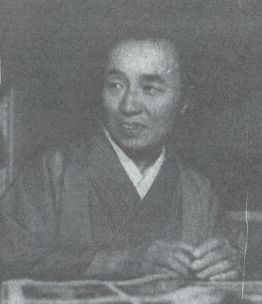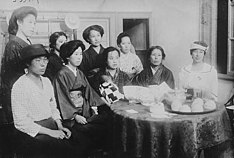
Fukuda Hideko, born Kageyama Hideko, was a Japanese feminist activist. She was educated at a young age and pursued socialist and feminist goals for most of her adult life. She was a participant in the Osaka Incident of 1885, where approximately 130 liberal activists were arrested on their way to attempt to incite revolution and liberate Korea. The group had planned to provide guns, bombs, and manpower to support reformist movements in Korea before the police intercepted them. After being freed, Fukuda continued to pursue social and gender reforms in Japan, playing an active role in the Freedom and People's Rights Movement which pushed for democratic changes to the government. She eventually established the magazine Sekai Fujin, which aimed at empowering women in Japan and getting them involved in international affairs. Throughout her life, Fukuda was involved in Japanese reform movements as they transitioned from aiming on increasing citizen's political rights to the more socialist-focused waves which attempted to exact nationwide social and economic revisions.

The New Women was a feminist ideal that emerged in the late 19th century and had a profound influence well into the 20th century. In 1894, writer Sarah Grand (1854–1943) used the term "new woman" in an influential article to refer to independent women seeking radical change. In response the English writer Ouida used the term as the title of a follow-up article. The term was further popularized by British-American writer Henry James, who used it to describe the growth in the number of feminist, educated, independent career women in Europe and the United States. The New Woman pushed the limits set by a male-dominated society. Independence was not simply a matter of the mind; it also involved physical changes in activity and dress, as activities such as bicycling expanded women's ability to engage with a broader, more active world.
Liberal feminism, also called mainstream feminism, is a main branch of feminism defined by its focus on achieving gender equality through political and legal reform within the framework of liberal democracy and informed by a human rights perspective. It is often considered culturally progressive and economically center-right to center-left. As the oldest of the "Big Three" schools of feminist thought, liberal feminism has its roots in 19th century first-wave feminism seeking recognition of women as equal citizens, focusing particularly on women's suffrage and access to education, the effort associated with 19th century liberalism and progressivism. Liberal feminism "works within the structure of mainstream society to integrate women into that structure." Liberal feminism places great emphasis on the public world, especially laws, political institutions, education and working life, and considers the denial of equal legal and political rights as the main obstacle to equality. As such liberal feminists have worked to bring women into the political mainstream. Liberal feminism is inclusive and socially progressive, while broadly supporting existing institutions of power in liberal democratic societies, and is associated with centrism and reformism. Liberal feminism tends to be adopted by white middle-class women who do not disagree with the current social structure; Zhang and Rios found that liberal feminism with its focus on equality is viewed as the dominant and "default" form of feminism. Liberal feminism actively supports men's involvement in feminism and both women and men have always been active participants in the movement; progressive men had an important role alongside women in the struggle for equal political rights since the movement was launched in the 19th century.
First-wave feminism was a period of feminist activity and thought that occurred during the 19th and early 20th century throughout the Western world. It focused on legal issues, primarily on securing women's right to vote. The term is often used synonymously with the kind of feminism espoused by the liberal women's rights movement with roots in the first wave, with organizations such as the International Alliance of Women and its affiliates. This feminist movement still focuses on equality from a mainly legal perspective.

Feminism in Japan began with women's rights movements that date back to antiquity. The movement started to gain momentum after Western thinking was brought into Japan during the Meiji Restoration in 1868. Japanese feminism differs from Western feminism in that less emphasis is placed on individual autonomy.

Ichikawa Fusae was a Japanese feminist, politician and a leader of the women's suffrage movement. Ichikawa was a key supporter of women's suffrage in Japan, and her activism was partially responsible for the extension of the franchise to women in 1945.

Hiratsuka Raichō was a Japanese writer, journalist, political activist, anarchist, and pioneering feminist in Japan.

Seitō, also known by its translated title Bluestocking, was a literary magazine created in 1911 by a group of five women: Haru Raichō Hiratsuka, Yasumochi Yoshiko, Mozume Kazuko, Kiuchi Teiko, and Nakano Hatsuko. The group called themselves the Japanese Bluestocking Society and used the magazine to promote the equal rights of women through literature and education. The magazine they developed was designed to articulate women’s self-awareness and the gender-based societal limitations they faced, but its promotion of early feminist beliefs through controversial publications caused it to be banned by the Japanese Home Ministry for being "disruptive to society". Members of The Bluestockings were berated by the press, and their private lives were a source of outrage for the public. Bluestocking produced 52 issues with over 110 contributors. It is credited as an influence for modern Japanese feminism.
Social feminism is a feminist movement that advocates for social rights and special accommodations for women. It was first used to describe members of the women's suffrage movement in the late nineteenth and early twentieth centuries who were concerned with social problems that affected women and children. They saw obtaining the vote mainly as a means to achieve their reform goals rather than a primary goal in itself. After women gained the right to vote, social feminism continued in the form of labor feminists who advocated for protectionist legislation and special benefits for women. The term is widely used, although some historians have questioned its validity.

Yamakawa Kikue was a Japanese essayist, activist, and socialist feminist who contributed to the development of feminism in modern Japan.
Shigeri Yamataka was a Japanese feminist and founder of the League for the Defense of Women's Rights. In 1952 she also took part in Chifuren, when it was formed, one of the largest women's organizations in Japan with more than 6 million members. She was also Chifuren's President.
The League of Women Voters of Japan is a Japanese NGO advocating equal rights for women. It was established by Senator Fusae Ichikawa and other feminists in 1945, when Japanese women obtained the right to vote, inspired by the American League of Women Voters. It has 51 branches throughout Japan, and is affiliated with the International Alliance of Women. The headquarters of the league are in Tokyo.

The feminist movement, also known as the women's movement, refers to a series of social movements and political campaigns for radical and liberal reforms on women's issues created by the inequality between men and women. Such issues are women's liberation, reproductive rights, domestic violence, maternity leave, equal pay, women's suffrage, sexual harassment, and sexual violence. The movement's priorities have expanded since its beginning in the 1800s, and vary among nations and communities. Priorities range from opposition to female genital mutilation in one country, to opposition to the glass ceiling in another.

Maternal feminism is the belief of many early feminists that women as mothers and caregivers had an important but distinctive role to play in society and in politics. It incorporates reform ideas from social feminism, and combines the concepts of maternalism and feminism. It was a widespread philosophy among well-to-do women in the British Empire, particularly Canada, from the late 19th century until after World War I (1914–18). The concept was attacked by later feminists as accepting the paternalist view of society and providing an excuse for inequality.

Mumeo Oku was an important Japanese feminist and politician who served three terms in Japan's Imperial Diet after having been a leader in the early modern women's suffrage movement in Japan. She played an important role in various early Japanese women's rights movements, and she was a crucial part of Japan's consumer movement. She was a renowned activist in the 1920s, co-founding the New Women's Association with Hiratsuka Raichō and Ichikawa Fusae, and eventually held a seat in the House of Councilors from 1947 to 1965 when she retired.
The Sekirankai was a Japanese socialist women's organization active in 1921. Members of an anarchist group established the organization in April 1921. Prominent feminists Yamakawa Kikue and Noe Itō were advisers for the group, which participated in that year's May Day activities, published the magazine Omedetashi, held seminars and lectures, and distributed anti-war leaflets to the army. Their manifesto condemned capitalism, arguing that it turned women into slaves and prostitutes. The Sekirankai was the first women's socialist association and clashed with Shin Fujin Kyōkai. The organization dissolved eight months after its creation.
The New Japan Women's League was a non-partisan women's organization in Japan formed by Fusae Ichikawa on November 3, 1945, after WWII. The NJWL was established to improve women's legal status in Japan, gain women's suffrage, develop policies for women's lives, education and work, and inform Japanese women about democracy and citizenship. The NJWL was influenced by pre-World War II suffrage organizations and did not mention gender equality or women in the workforce in its founding principles. NJWL and Ichikawa worked to "struggle against conservative social taboos." NJWL lobbied the government over laws and policies that were unequal in treatment of men and women. In 1950, New Japan Women's League was renamed to the Women's Suffrage League of Japan. Thereafter, Women's Suffrage League of Japan had the basic principles of "equality, welfare, political purification, and permanent world peace" and promoted movements that connect between women and the Diet.
The New Women's Association was a Japanese women's rights organization founded in 1919. The organization strove to enhance women's rights in the areas of education, employment, and suffrage. It also aimed to protect women from venereal disease by attempting to prevent men with these diseases from marrying, as well as by allowing women whose husbands had these diseases to get a divorce. The organization played an important role in changing Article 5 of the Public Peace Police Law, which had prohibited women from participating in public meetings. NWA also enlisted the help of men as advocates for women in politics.
Shigeyo Takeuchi (竹内茂代) was a Japanese physician. She was one of the first women elected to the Japanese Diet, though she only served one term.
The Fusen Kakutoku Dōmei, originally named Fujin Sanseiken Kakutoku Kisei Dōmei, was a Japanese women's rights organisation, founded in 1924. Its purpose was to work for the introduction of women's suffrage.













